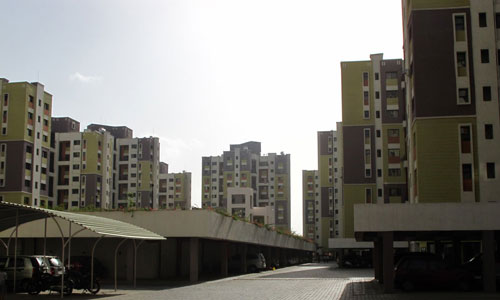
Indian real estate sector outlook for 2012: Fitch Ratings
Fitch Ratings’ outlook for 2012 for the Indian real estate sector is negative due to weak overall demand and higher construction costs, which are likely to continue to squeeze margins.

Fitch Ratings’ outlook for 2012 for the Indian real estate sector is negative due to weak overall demand and higher construction costs, which are likely to continue to squeeze margins.

The housing and real estate sector in India witnessed foreign direct investment (FDI) of $2.8 billion in the fiscal year (April-March) 2009-10, according to Indian Department of Industrial Policy and Promotion. The statistics made available to the media at the India Home property exhibition, which concluded in Dubai on Sunday, revealed that total NRI FDI inflows through the period April-December 2009-10 stood at $320.05 million.

At a time when there is a mad rush to launch new projects in & around the airports across the cities of India, a developer in Bengaluru opted to go in the diametrically opposite direction. Prima facie, what appeared to be a case of finding a better or affordable land parcel in that given location of South-West Bengaluru had a strategy that very few adopt in the business of Indian real estate. The strategy to define demand through scientific research. The demand in the market was assessed with consumer psychograph study – what consumers want; what they need; where are the gaps; and how a new housing project could fill in that gap.

Equity capital inflows touched USD 8.9 billion between January and September, registering a 46% Y-o-Y growth. The strong momentum in deal volume continued, with about 200 deals reported during this period, compared to 151 deals in the same period last year. The average deal size also increased to nearly USD 45 million in the first nine months of 2024 from about USD 36 million in 2023. Mid-sized deals, ranging between USD 10-50 million, represented 56% of the total investment inflows during this period.

Uniform Builder Buyer Agreement (BBA) has been the demand of Indian home buyers for long. In the absence of it, while the home buyers were being harassed by the unscrupulous builders, the sector was at the receiving end of poor perception in the collective consciousness. Track2Realty evaluates whether a Model Builder Buyer Agreement will be a reality after the repeated interventions by the Supreme Court of India.

Prices of key materials like steel and aluminum have relatively stabilized in 2024. Rising construction cost has primarily been on account of labour cost surge, at about 25% YoY in the private sector. Volatilities in construction material prices and labour cost pressures are likely to push overall construction cost upward, albeit at a slower pace. Over the last one-year, average cost of construction is estimated to have risen up to 11%, mainly due to a significant surge in labour costs coupled with a moderate price increase in construction materials like sand, brick, glass, wood etc. Notably, the cumulative effect of rise in the prices of four key construction materials including cement, steel, copper and aluminum have been relatively low. In fact, average cement prices have seen a steep decline of 15%, while average steel prices have witnessed a ma

How was the festive season for property market this year? The answer depends upon whom are you addressing the question. For the large universe of the developers, it was worse festive season in the last 5-7 years. But for a few select listed developers, the fortunes are different. The ground reality of the market is that Diwali fireworks was definitely missing for Indian real in 2024, despite over optimism and influence peddling ahead of the festive season. Track2Realty analysis.

Very few budget announcements in recent past have raised as many queries as the LTCG (Long Term Capital Gains) Tax. After all, it concerns all of us, the common citizens of India, whether they are lower class or middle class. For the rich, it has always been a case of more tax reliefs than burden. Track2Realty is regularly getting queries with the underlying worry as to whether the LTCG Amendment makes the tax computation simpler or more complicated.

India continues to exhibit strong economic growth prospects and business optimism is reflected in the increasing number of Initial Public Offerings (IPOs) in recent years. The traction in the number and volume of public issues lends credibility to an environment of higher corporate earnings, rising participation by retail and institutional investors, and availability of adequate liquidity in the market. With 123 fresh issues (As of 20th October 2024) across multiple sectors, 2024 has already surpassed the total number of IPOs witnessed in 2023.

As the education sector evolves, factors such as technology permeation, revamped building designs, and focus on health & safety are likely to define education real estate. Besides, modern educational building design must prioritise flexibility so that spaces can be reconfigured to adapt to various teaching methods and activities, developing a dynamic learning environment. To address this and move away from traditional classroom setups, educational buildings now include collaborative spaces to encourage teamwork and group learning. Moreover, sustainable, and eco-friendly design elements, such as energy-efficient systems and natural lighting, are becoming increasingly common to reduce the environmental impact of educational buildings.
